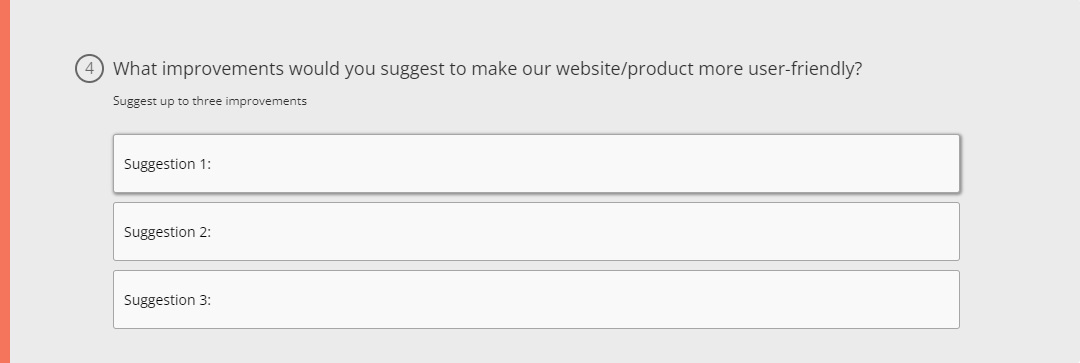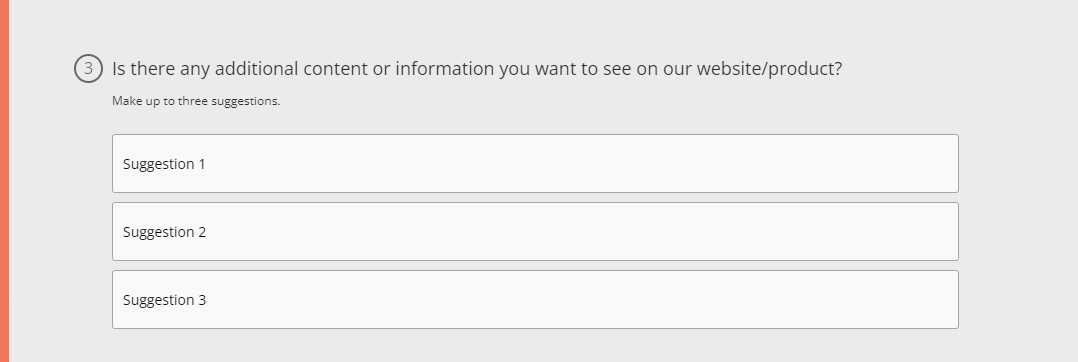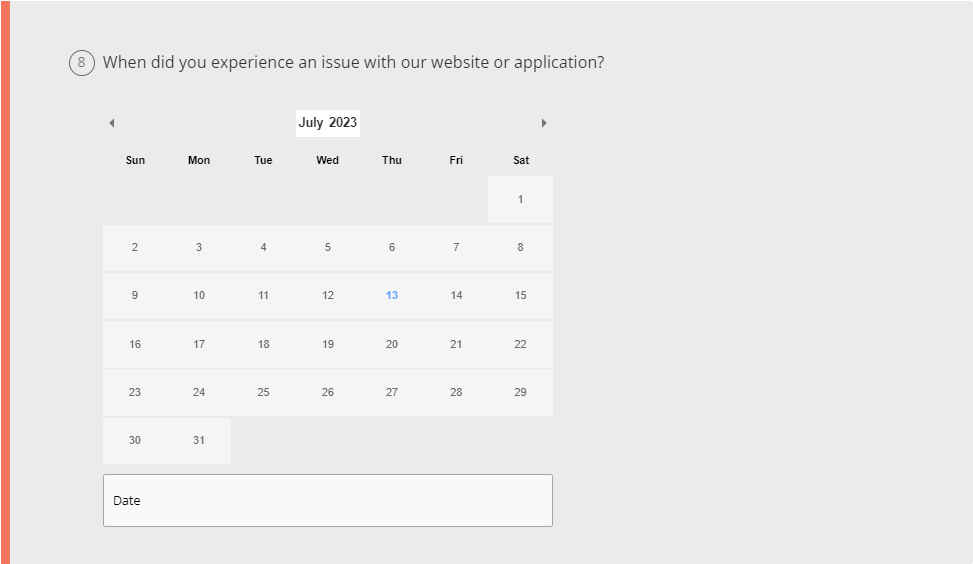User experience (UX) surveys play a pivotal role in shaping the success of products and services. To ensure user satisfaction, businesses must understand customer needs, preferences, and pain points.
In this article, we’ll explore the key elements of crafting user experience survey questions that yield meaningful feedback. We’ll also provide a comprehensive list of example user experience survey questions to help you get started.
What is user experience?
User experience (UX) refers to the interaction and perception that users have when engaging with a product, website, application, or service.
It encompasses all aspects of a user’s experience, including their emotions, attitudes, behaviors, and satisfaction levels throughout their journey. User experience takes into account various factors such as:
- Usability
- Accessibility
- Visual design
- Content clarity
- Responsiveness
- Fulfillment of user goals and expectations
It focuses on creating intuitive, meaningful, and enjoyable experiences that meet the needs and desires of the users. By prioritizing UX, businesses can raise customer satisfaction, increase engagement, and build long-lasting relationships with their target audience.
How do you survey user experience?
Let’s delve into each step of the user experience survey process to guide you in unlocking valuable feedback.
-
Determine your goals:
Clearly define the objectives of your user experience survey. What specific insights or information are you seeking to gather? Understanding your goals will help shape the survey design and question selection.
-
Select a survey method:
Decide on the most suitable method for your survey, considering factors such as your target audience, resources, and timeline.
-
Design your survey questions:
Write clear questions that align with your goals. Utilize a mix of question types such as Likert scales, multiple-choice, open-ended, ranking, and rating scales to capture a comprehensive view of the user experience.
-
Sequence the questions:
Organize the survey questions in a logical flow. Start with your most important questions, this ensures you collect the data you need even if respondents drop out. Place the most important questions upfront to capture respondents’ attention and engagement.
-
Pilot test your survey:
Before launching the survey, conduct a pilot test with a small group of participants. This step helps identify potential issues with question clarity, response options, or survey length. Make adjustments as necessary based on the pilot feedback.
-
Distribute the survey:
Depending on your chosen method, distribute the survey to your target audience. This can involve sharing a link, in-person interviews, usability testing sessions, or even in-app surveys.
-
Collect and analyze the data:
As responses come in, collect and compile the data. Ensure that the data is stored securely and protected. Once collected, analyze the data to gain insights and identify patterns, trends, and areas for improvement.
-
Draw conclusions and take action:
Analyze the survey findings and draw conclusions based on the data. Use these insights to make informed decisions, prioritize improvements, and enhance the user experience of your product or service.
Types of survey questions in UX
It’s important to use a mix of question types to reduce survey fatigue and increase response rates.
Here are some commonly used question types in UX surveys:
- Likert Scales: Measures respondents’ level of agreement with a statement or question on a scale, typically ranging from “Strongly Disagree” to “Strongly Agree.”
- Multiple-Choice Questions: Provides predefined response options for participants to choose from.
- Open-Ended Questions: Allows respondents to provide detailed, open-ended feedback and insights.
- Ranking: Asks participants to prioritize a list of items based on their preferences or importance.
- Rating: Evaluates specific aspects on a numerical scale, such as satisfaction levels or usability ratings.
- Binary: Typically, these are Yes/No questions that allow you to filter survey results based on opposing opinions.
Examples of user experience survey questions
To help you kickstart your survey, here’s a list of example UX survey questions you can ask potential and existing customers.
With each question, we’ll recommend the best question type to use. You should be able to find these with any survey software, but you can rest assured that Shout offers them all.
Customizing these questions to fit your industry will provide you with valuable feedback to identify areas for improvement.
Overall satisfaction questions
Use these questions to understand areas of strength and identify opportunities for improvement to enhance overall user satisfaction.
- On a scale of 1-10, how satisfied are you with the overall user experience?
[Opinion Scale]
- Did our website/product/service provide value to you?
[Binary Yes/No]
- How likely are you to recommend our product/service to others?
[Net Promoter Score]
- What aspects of our product/service do you appreciate the most?
[Multiple-Choice (Multi-Select)]
- Is there anything about our product/service that you find frustrating?
[Comment Box]
- What made you choose us over our competitors?
[Multiple-Choice (Multi-Select)]
- Would you consider using our website/product/service again in the future?
[Binary Yes/No]
- How well did our website/product/service fulfil your needs or requirements?
[Matrix / Likert Scale]
- Is there anything we can do to improve the overall user experience based on your feedback?
[Comment Box]
Usability questions
Assess users’ experience in terms of navigation, efficiency, clarity of instructions, and overall usability.
- How easy is our product/ application to use?
[Matrix / Likert Scale]
- Which specific features or elements were confusing or difficult to use?
[Multiple-Choice (Multi-Select]
- Were you able to accomplish your goals using our website/product?
[Binary Yes/No]
- What improvements would you suggest to make our website/product more user-friendly?
[Textbox (Multiple)]
- What’s the most difficult part of the application to navigate?
[Dropdown List]
- How useful was our help documentation in helping you understand our product/service?
[Matrix / Likert Scale]
- Did you feel that the overall layout and organization of our website/product is intuitive?
[Binary Yes/No]
- How well did our website/product guide you through the different steps or processes?
[Opinion Scale]
Visual design and layout questions
These questions assess the users’ perception of aesthetics, usability, and brand consistency.
- Out of 5 stars, how would you rate the visual design of our website?
[Star Rating]
- Are there any aspects of the design that you would like to see improved?
[Comment Box]
- Does the visual design of our website/product align with the overall brand image?
[Binary Yes/No]
- Are there any design elements that distract or hinder your experience?
[Text Boxes (Multiple)]
- How easily were you able to easily navigate and find your way around our website/product?
[Matrix / Likert Scale]
- Did you find the placement of content or features intuitive and user-friendly?
[Binary Yes/No]
- How well did the visual design contribute to your overall understanding of the information or functionality provided?
[Opinion Scale]
- Is there anything we can do to improve the visual design and layout of our website/product based on your experience?
[Comment Box]
Content relevancy and clarity questions
By understanding the user’s opinion on content quality and relevance, you can enhance user experience.
- Did you find the information presented relevant to your needs?

- Was the content easy to understand and digest?

- Is there any additional content or information you want to see on our website/product?
[Text Boxes (Multiple)]
- How well did the content provided address your questions or concerns?
[Opinion Scale]
- Did you find the language and tone of the content appropriate and engaging?
[]Binary Yes/No]
- How satisfied are you with the information on our website?
[Matrix / Likert Scale]
- How easy was it to find the information you were looking for on our website/product?
[Matrix / Likert Scale]
Performance and speed questions
These questions aim to gather feedback on the performance and speed aspects of the user experience. They cover areas such as responsiveness, loading times, navigation, and overall satisfaction.
- Did you experience any issues with the website/product performance or speed?
[Binary Yes/No]
- Does our website/product respond quickly to your interactions?
[Slider]
- Have you encountered any delays or lags while using our website/product?
[Binary Yes/No]
- How satisfied are you with the overall performance and speed of our website/ application?
[Matrix / Likert Scale]
- How quickly did our website/product load pages or screens for you?
[Opinion Scale]
- Were you able to smoothly navigate different sections or features of our website/product?
[Binary Yes/No]
- Is there anything we can do to improve the performance and speed of our website/product based on your experience?

- When did you experience an issue with our website or application?
[Date]
Customer support questions
These questions aim to gather feedback on various aspects of the customer support experience. This includes satisfaction levels, the effectiveness of communication, issue resolution, and overall quality of service.
- How satisfied are you with the level of customer support provided?
[Matrix / Likert Scale]
- Were your inquiries or issues resolved in a timely manner?
[Binary Yes/No]
- Did the customer support representative address your concerns adequately?
[Binary Yes/No]
- Did the customer support representative provide clear explanations or instructions?
[Opinion Scale]
- Is there anything we can do to improve our customer support experience?
[Comment Box]
- How likely are you to recommend our customer support agents to others?
[Net Promoter Score]
- Were you satisfied with the communication channels available for contacting our support team?
[Matrix / Likert Scale]
User experience survey questions: wrapping up
User experience survey questions are crucial for gathering meaningful feedback that drives improvements in products and services.
By understanding the purpose of your survey, employing different question types, and utilizing the provided example questions, you gain insights and enhance the user experience.
Remember, well-crafted survey questions lead to actionable feedback that helps you create products that meet your users’ needs.




